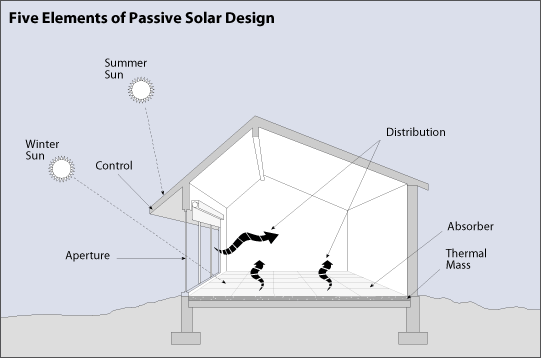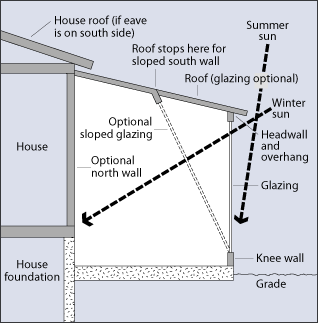Passive Solar House Plans:
The Essentials
Passive solar house plans can save you significant energy costs. Why? Because the plan is designed to "passively" collect, store, and distribute the sun's energy in the winter AND also reject the sun's energy in the summer.
"Active" solar design, on the other hand, involves the use of mechanical and electrical devices to utilize solar energy.
The sun provides a tremendous amount of heat, although the amount of heat it provides does vary depending on your location on the globe.
That heat can be controlled through proper house design, to maximize its heating ability when you want heat (in the winter) and to minimize its heating ability when you don't want heat (in the summer).
There are four key components to successful passive solar design:
1. Windows ("apertures"): These are the collectors through which the sunlight enters the home. In a passive solar house plan, the majority of the home's windows are on the south-facing side to maximize wintertime heating. In order to minimize undesirable solar gain in the summer, passive solar house plans may have no windows/glass on the east or west-facing sides of the house.
2. Materials that retain or store the sun's heat, also called "thermal mass." In some designs, a separate absorber, or the surface of the thermal mass, is also present. Often, though, the thermal mass is a concrete and/or tile floor.
3. Heat distribution: This is how the solar heat circulates after entering the windows to different areas of the house. Fans, ducts, and blowers can sometimes be used to assist this process.
4. Heating control: The primary means is to use deliberately designed roof overhangs. Blinds, electronic sensing devices, vents/dampers, and awnings can also be used to control the amount of solar heating in the home.
These key components are illustrated below:

Courtesy of the Department of Energy.
Special software tools can help designers customize a passive solar house plan to your specific needs. For example, the passive solar design needs of someone who lives in Anchorage, Alaska is very different from the person who lives in Miami, Florida. Yet both people can utilize passive solar design techniques to minimize their utility bills.
You may have noticed that the sun appears at different heights in the sky at different times of the year. Generally speaking, the winter sun is lower in the sky, and the summer sun is higher in the sky. Designers can calculate the angle of the sun at different times of the year according to where you live, and design the house plan accordingly. Custom-designed roof overhangs allow the designer to integrate a "sun control" feature into each house plan, as shown in the illustration below.

Courtesy of the Department of Energy.
Some of you may think of some pretty funky designs when you think of "solar" home design. I can remember visiting the passive solar homes of my parents' friends back in the 70s, and I always thought they looked odd. But designers have learned a lot through the past few decades, and you need not have a strange-looking house in order to harness the effects of solar energy. You'll find more information about solar house plans here.
Return from Passive Solar House Plans to Solar House Plans.
Return from Passive Solar House Plans to the Home Page.





